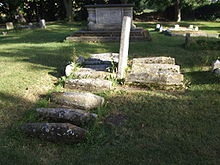- Cooling, Kent
-
Coordinates: 51°27′19″N 0°31′34″E / 51.4553°N 0.5262°E
Cooling
 Cooling shown within Kent
Cooling shown within KentPopulation 209 OS grid reference TQ755760 Parish Cooling Unitary authority Medway Ceremonial county Kent Region South East Country England Sovereign state United Kingdom Post town ROCHESTER Postcode district ME3 Dialling code 01634 Police Kent Fire Kent Ambulance South East Coast EU Parliament South East England UK Parliament Medway to be replaced 2007 by Rochester and Strood List of places: UK • England • Kent Cooling is a village and civil parish on the Hoo Peninsula, overlooking the North Kent Marshes. According to the 2001 census the parish had a population of 209.
This remote and isolated hamlet has been described as 'the capital of English Lollardry' because of its association with Sir John Oldcastle. The most notable feature of the village is Cooling Castle, built on the edge of the marshes during the 12th century to defend the neighbouring port of Cliffe from the threat of French raiders.
Contents
Cooling Castle
Sir John de Cobham, third Baron Cobham inherited a 700 acre (2.8 km²) estate at Cobham from his father Henry in 1335, originally acquired by the de Cobhams in 1241. John Lord Cobham later built the castle in 1381, as he was in charge of the defence of Kent but a successful raid by the Spanish and French up to Gravesend spurred the king to realize the defence was needed. For in 1379 French vessels appeared in the Thames, with a body of French and Spanish soldiers who 'ravaged all this part of Kent', so that every town and village near the river fell to them. Sir John de Cobham died in a Monastery in Maiden-Bradley in 1408.
The castle, described as 'startling white-stone, drum-towered gatehouse and moated ruins of Cooling Castle' (Arnold), has two excellent and well proportioned half-round towers and entrance built by Thomas Crump of Maidstone. From the road, these are the most visible parts of the castle. The castle was constructed by the stonemason Henry Yeverle, who also worked extensively on the Palace of Westminster and the Tower of London. In 1381, the castle began to take shape, obtaining licence from King Richard to 'crenellate and fortify it'.
In 1413 the castle was owned by Sir John Oldcastle, the model for Shakespeare's character Falstaff.
The name of Brooke was derived from Sir Thomas Brooke, who was wed to the daughter and only surviving child of the Lady Joan de Cobham, by Sir Reginald Braybrooke. It was Braybrooke who bequeathed Cooling Castle into the de Cobham estate, although that family maintained Cobham Hall even then as its main residence.
Nevertheless, Cooling castle was stormed by Sir Thomas Wyatt in 1554 during the Kentish uprising against Queen Mary and after the failure of Lord John Dudley, Duke of Northumberland to install Lady Jane Grey on the throne.
That Sir Thomas Wyatt stormed Cooling Castle so easily may be explained by the interesting detail that the same was a nephew of Lord Cobham. Sir Thomas Wyatt was the son of Elizabeth Brooke, Cobham's sister, so his complicity with Dudley and Grey was 'a natural expression of his intimate love of England'. Wyatt held large estates in the Hundred of Hoo apart from those of his uncle, Lord Brooke of Cobham. His home was at Allington Castle on the River Medway.
It was George, Lord Cobham, in the year following his release from the Tower of London, who was instructed to entertain Cardinal Pole during the papal legate's visit to England during a formal reconciliation with Rome. This entertainment is recorded as having taken place at Cooling Castle, in about 1555, and is the last known reference to the Cobham family using the castle as a home. It had formally been somewhat damaged by the Duke of Norfolk's cannon in the attempt to force Wyatt's surrender during that uprising against Mary I.
During the 1990s the property was owned by the Rochester bridge wardens. The more recent residential parts of the castle are still in use — as at November 2008 it is owned by Jools Holland.
St James' church
Main article: St James' Church, CoolingThe village church of St James dates from the late 13th century.[1] It has long been classified 'redundant', and is therefore no longer used for worship, but is maintained by the Churches Conservation Trust and open to visitors daily. Jools Holland was married there in August 2007. In the churchyard are a group of children's gravestones which are widely considered to have inspired Charles Dickens' description of the churchyard in the opening scene of the novel Great Expectations.[2]
References
- ^ "St James, Cooling". Churches Conservation Trust. http://www.visitchurches.org.uk/findachurch/st-james-cooling/?region=Kent. Retrieved 2010-01-13.
- ^ Great Expectations, notes by Charlotte Mitchell in Penguin Classics 2003 edition, ISBN 9780141439563
External links
http://www.CoolingChurch.org.uk
Towns and villages in the Unitary authority of Medway in Kent, England Allhallows · Borstal · Brompton · Chatham · Chattenden · Cliffe · Cliffe Woods · Cooling · Cuxton · Frindsbury · Frindsbury Extra · Gillingham · Halling · Hempstead · High Halstow · Hoo St Werburgh · Isle of Grain · Lordswood · Rochester · Rainham · Rainham Mark · St Mary Hoo · St Mary's Island · Stoke · Strood · Twydall · Upnor · Wainscott · Walderslade · WigmoreList of places in Kent Categories:- Medway
- Villages in Kent
- Civil parishes in Kent
Wikimedia Foundation. 2010.



